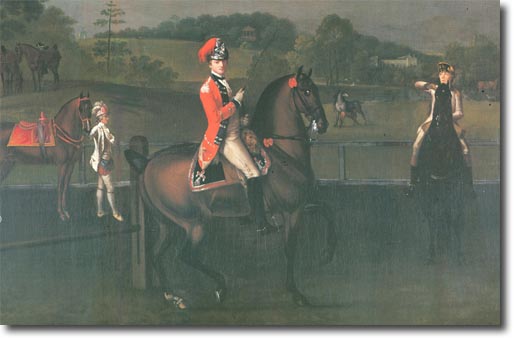|
|

 |
|
John's father was a Captain-Lieutenant in the King's Dragoon Guards who fought and was wounded at Minden. He died of his wounds on 12th October 1759, and John, his eldest son was put into the care of the Earl of Pembroke who was, at the time, second in command of the 15th Light Dragoons. In recognition of his father's services, John was given a cornetcy without purchase, at the age of 12. At the battle of Emsdorf, he was riding a horse lent to him by the Earl of Pembroke but it was killed, leaving young Floyd perilously close to the French infantry. He was saved by Captain Ainslie of the 15th.
After the battle he stayed with the Earl of Pembroke, an expert horseman and author on the subject, at Utrecht where he must have honed his skills as a rider because when he returned to England with the regiment in April 1763 he was appointed riding-Master. When the Earl was made commanding officer of the 1st Royal Dragoons, he arranged for John to come to that regiment to train the men according to Pembroke's methods. As Lieutenant-Colonel John Floyd, he was given command of a new regiment, the 23rd Light Dragoons, he took it to India as a result of the East India Company's plea to the Government for a British Cavalry regiment to help fight the Mahrattas. Unfortunately, the regiment suffered from lack of horses and were unable to perform as well as expected. But John's teaching methods laid the foundation of horsemanship for many years to come in India. In 1790 he led the British cavalry against Tippoo in the renewed Mysore War. He fought against Said Sahib's army of 4,000 horsemen and drove them back. He claimed that he had 'established for the first time in India, the infinite superiority of European over Native Horse.' The enemy finally gained the upper hand and Floyd's cavalry was isolated, but fought bravely to rejoin the main force. At the siege of Bangalore in March 1791, Colonel Floyd led a courageous charge against overwhelming odds. In this action he received a bullet wound in the cheek and neck but was brought back to safety. He was back in action within ten days but the bullet stayed in his neck for the rest of his life. The painting, shown her, is by David Morier and shows Floyd in the uniform of the 15th Light Dragoons c1768. The uniform has blue facings and silver lace. The other mounted figure is an officer of the Light Troop of the Royal Dragoons. The other figure, on the left, in an unusual costume, is a lady called Kitty Hunter who was the daughter of a Lord of the Admiralty. The Earl of Pembroke eloped with her, although he was already married, in January 1762.
1748 Born on 22nd February. |
Armed Forces | Art and Culture | Articles | Biographies | Colonies | Discussion | Glossary | Home | Library | Links | Map Room | Sources and Media | Science and Technology | Search | Student Zone | Timelines | TV & Film | Wargames
